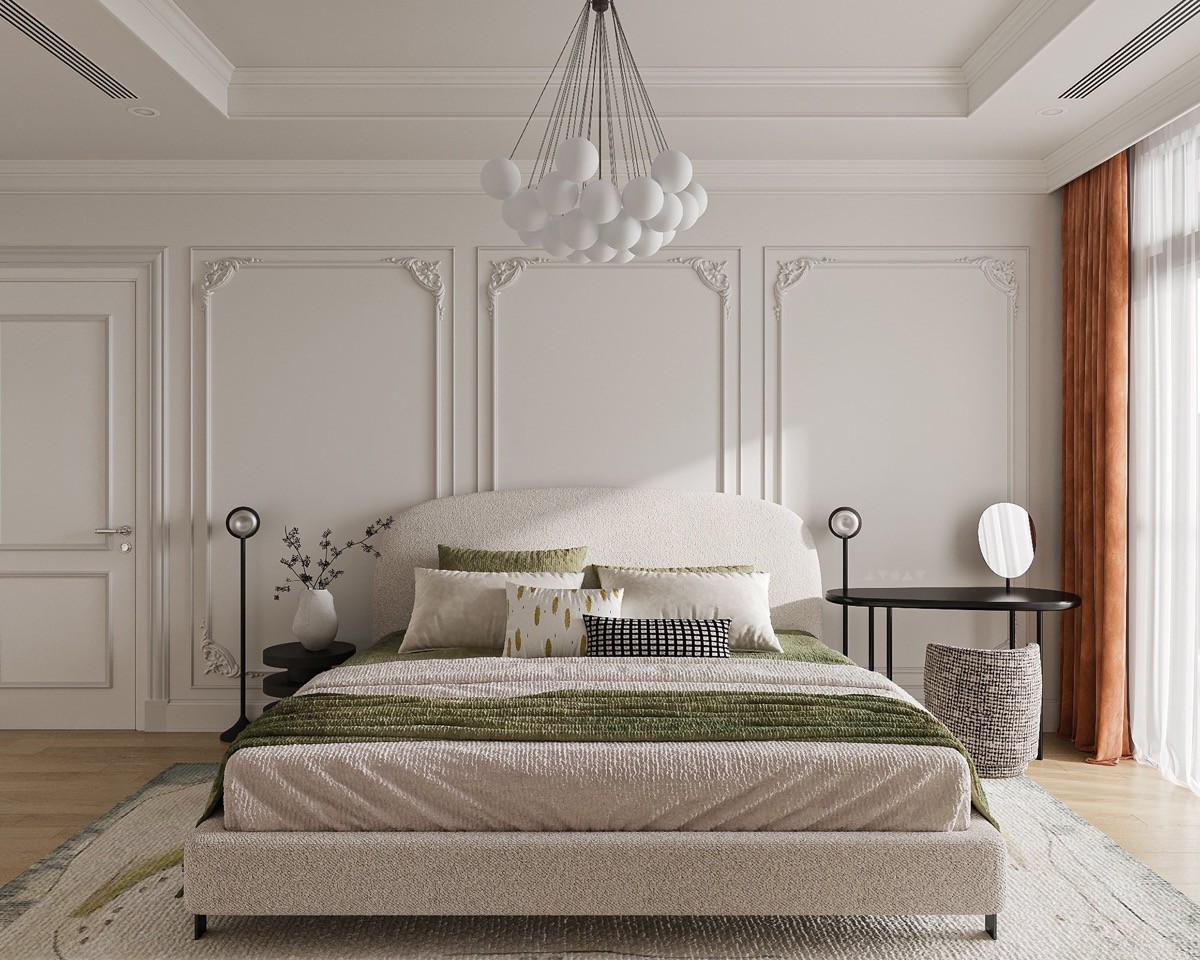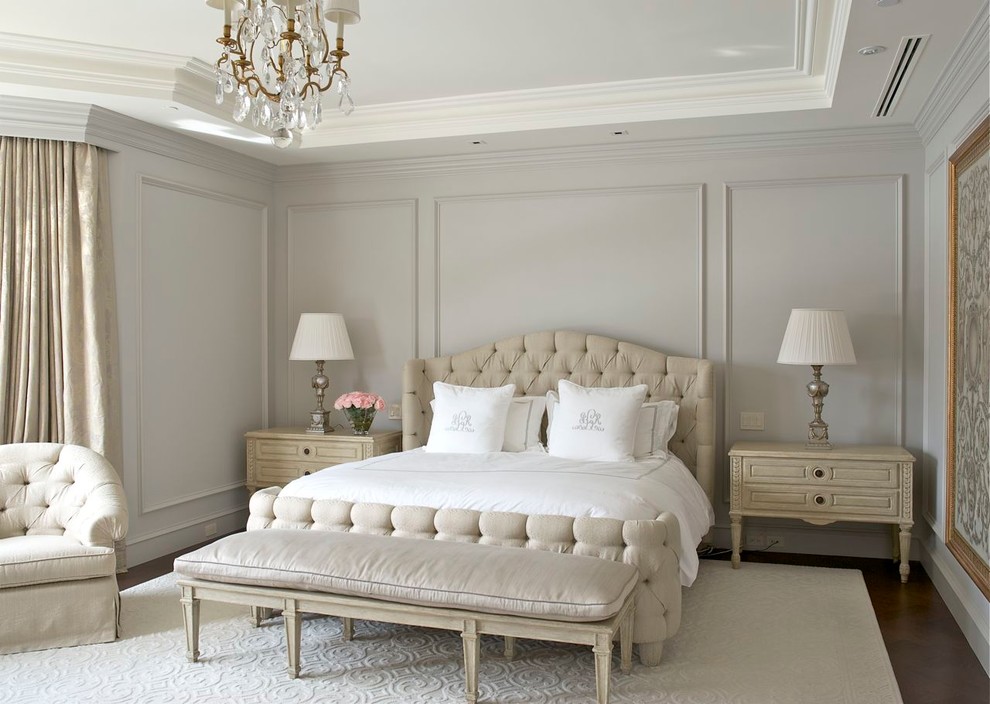Types of Wall Molding

Wall molding is a decorative element that can add visual interest and architectural detail to a bedroom. It can also help to define spaces, create a sense of elegance, and enhance the overall aesthetic of the room. There are several types of wall molding available, each with its own unique style and application.
Crown Molding
Crown molding is a decorative trim that is typically installed at the junction of the wall and ceiling. It adds a touch of sophistication and elegance to a room, making it appear taller and more spacious. Crown molding is often used in bedrooms to create a more formal or traditional look.
Crown molding can be made from various materials, including wood, polyurethane, and plaster.
- Traditional crown molding is typically characterized by intricate carvings and ornate details, such as dentil molding, ogee molding, and cove molding.
- Modern crown molding is often simpler and more minimalist, with clean lines and geometric shapes. It can be made from materials such as polyurethane or MDF, which are more affordable and easier to install than traditional wood molding.
Chair Rail
Chair rail molding is a decorative trim that is typically installed about 36 inches above the floor. It serves both a functional and decorative purpose.
- Functionally, chair rail molding can help protect the walls from scuffs and scratches caused by chairs and other furniture.
- Decoratively, chair rail molding can add a touch of elegance and style to a bedroom.
Chair rail molding is often used in bedrooms with wainscoting, which is a paneling that extends from the floor to the chair rail height.
- Traditional chair rail molding is often made from wood and features simple, classic designs.
- Modern chair rail molding can be made from various materials, including polyurethane and MDF, and can feature more contemporary designs.
Baseboard
Baseboard molding is a decorative trim that is installed along the base of the walls. It serves a practical purpose by covering the gap between the wall and the floor, but it also adds a touch of style to a room.
Baseboard molding can be made from various materials, including wood, polyurethane, and MDF.
- Traditional baseboard molding is often made from wood and features simple, classic designs.
- Modern baseboard molding can be made from various materials, including polyurethane and MDF, and can feature more contemporary designs.
Picture Rail
Picture rail molding is a decorative trim that is typically installed about 6 inches below the ceiling. It serves a functional purpose by providing a convenient way to hang pictures and artwork without damaging the walls.
Picture rail molding is often used in bedrooms to create a gallery wall or to display cherished photographs and artwork.
- Traditional picture rail molding is often made from wood and features simple, classic designs.
- Modern picture rail molding can be made from various materials, including polyurethane and MDF, and can feature more contemporary designs.
Wall Molding Styles and Designs

Wall moldings are more than just decorative trims; they can transform the look and feel of a room, adding depth, dimension, and character. Understanding the different styles and designs available allows you to choose the perfect molding to complement your bedroom’s aesthetic and create a cohesive and visually appealing space.
Traditional Wall Molding Styles
Traditional molding styles often feature intricate details and ornate designs, reflecting a timeless and elegant aesthetic. These styles are popular for creating a classic and sophisticated look in bedrooms.
- Casing Molding: This type of molding surrounds doors and windows, creating a frame that adds visual interest and definition to these architectural features. Traditional casing molding often features intricate details like beading, ogees, or cove profiles.
- Chair Rail Molding: This horizontal molding is typically placed about 3 feet from the floor, providing protection to the wall from furniture and adding visual interest to the lower portion of the wall. Chair rail molding can be simple or ornate, depending on the desired style.
- Picture Rail Molding: This horizontal molding is placed near the ceiling, allowing you to hang pictures without damaging the wall. Traditional picture rail molding often features decorative details like dentils or acanthus leaves.
Modern Wall Molding Styles, Wall molding ideas for bedrooms
Modern molding styles are characterized by clean lines, geometric shapes, and minimalist designs. These styles are perfect for creating a sleek and contemporary look in bedrooms.
- Flat Molding: Flat molding is characterized by its simple, unadorned profile, often featuring a rectangular or square shape. It adds subtle definition to walls without overwhelming the space.
- Angular Molding: Angular molding features sharp angles and geometric shapes, creating a bold and modern statement. This type of molding can be used to create geometric patterns on walls or highlight specific areas.
- Shadow Box Molding: Shadow box molding creates a recessed panel effect on the wall, adding depth and dimension. It is often used to highlight a focal point in the room, such as a headboard or artwork.
Farmhouse Wall Molding Styles
Farmhouse molding styles evoke a sense of rustic charm and warmth, often featuring simple, yet elegant designs. These styles are perfect for creating a cozy and inviting atmosphere in bedrooms.
- Board and Batten Molding: This type of molding features vertical boards with horizontal battens, creating a rustic and textured look. Board and batten molding can be used to create wainscoting or to accentuate a wall.
- Shiplap Molding: Shiplap molding features overlapping planks that create a seamless and textured surface. It adds a rustic and cozy feel to bedrooms, often used on accent walls or behind headboards.
- Beadboard Molding: Beadboard molding features small, raised beads that create a subtle texture and pattern. It is often used on walls or ceilings to add a touch of rustic charm.
Contemporary Wall Molding Styles
Contemporary molding styles are characterized by their bold and innovative designs, often incorporating unexpected shapes and textures. These styles are perfect for creating a modern and unique look in bedrooms.
- Geometric Molding: Geometric molding features abstract shapes and patterns, adding a touch of whimsy and sophistication to the room. It can be used to create a focal point or to break up large walls.
- Textured Molding: Textured molding features unique surface patterns, adding visual interest and depth to walls. This type of molding can be used to create a statement wall or to highlight a specific area.
- Custom Molding: Custom molding allows you to create unique designs that reflect your personal style. It can be used to create intricate patterns, geometric shapes, or even personalized details.
Designing a Bedroom with Wall Molding
To illustrate the versatility of wall molding, let’s design a bedroom using different styles:
Bedroom Design: Imagine a spacious bedroom with a neutral color palette and large windows. We’ll use molding to create a cozy and inviting atmosphere while highlighting the room’s architectural features.
Wall Molding Choices:
- Headboard Wall: For the headboard wall, we’ll use a combination of modern and farmhouse styles. A shadow box molding will frame the headboard, creating a focal point and adding depth to the wall. To complement this, we’ll add shiplap molding to the lower portion of the wall, extending from the floor to the shadow box. This combination creates a modern yet cozy aesthetic.
- Window Trim: To enhance the windows, we’ll use traditional casing molding with simple beading for a classic and elegant look. This choice complements the overall aesthetic of the room while highlighting the architectural features.
- Accent Wall: For an accent wall, we’ll use geometric molding in a subtle pattern to add visual interest without being overwhelming. This choice adds a touch of contemporary flair to the room while maintaining a cohesive look.
Wall Molding Patterns and their Effects on Room Aesthetics
The arrangement and patterns of wall molding can significantly impact a room’s aesthetics.
Examples:
- Vertical Molding: Creates a sense of height and grandeur, making the room appear larger.
- Horizontal Molding: Adds visual interest to the wall and can help to define different areas within the room. It can also make the room appear wider.
- Grid Molding: Creates a symmetrical and structured look, adding a sense of order and sophistication to the room.
- Diagonal Molding: Adds a dynamic and unexpected element to the room, creating a sense of movement and energy.
Installing and Finishing Wall Molding: Wall Molding Ideas For Bedrooms

Installing wall molding can transform a bedroom from basic to beautiful. It’s a DIY project that can be done in a weekend, and the results are well worth the effort.
Tools and Materials
To install wall molding, you’ll need the following tools and materials:
- Wall molding (choose the type and style that suits your bedroom)
- Measuring tape
- Level
- Pencil
- Miter saw or hand saw
- Nail gun or hammer and nails
- Caulk gun
- Caulk
- Wood filler
- Putty knife
- Sandpaper
- Primer
- Paint
- Paint brushes
Cutting and Measuring
Before you start installing, it’s essential to cut and measure the molding pieces accurately. Here’s how to do it:
- Measure the length of each wall where you want to install the molding.
- Mark the measurements on the molding using a pencil.
- Use a miter saw or hand saw to cut the molding at the marked points. A miter saw ensures precise 45-degree angles for corners.
- Remember to factor in the thickness of the molding when measuring and cutting.
Securing the Molding
Once you’ve cut the molding pieces, you can start securing them to the walls:
- Use a level to ensure that the molding is straight and even.
- Apply a thin bead of construction adhesive to the back of the molding.
- Press the molding firmly against the wall, holding it in place for a few seconds.
- Secure the molding with nails or a nail gun, driving them into the wall at an angle to ensure a strong hold.
- Repeat this process for all the molding pieces.
Filling Gaps and Finishing
After installing the molding, you’ll need to fill any gaps or holes:
- Use wood filler to fill any gaps between the molding and the wall.
- Use caulk to fill any gaps between the molding pieces.
- Let the wood filler and caulk dry completely.
- Sand the filled areas smooth using sandpaper.
Painting and Finishing
Finally, it’s time to paint and finish the molding:
- Apply a coat of primer to the molding to create a smooth surface for the paint.
- Let the primer dry completely.
- Apply two coats of paint to the molding, allowing each coat to dry completely before applying the next.
- Once the paint is dry, you can add any finishing touches, such as decorative trim or paint accents.
Wall molding ideas for bedrooms – Wall molding, like delicate lace on a canvas, adds dimension and elegance to any bedroom. But for a space that whispers tranquility, consider the harmonious blend of light and airy bedroom ideas, such as those found in this inspiring guide , to create a haven of serenity.
From subtle shadow lines to graceful curves, wall molding can subtly enhance the airy feel, echoing the lightness of the overall design.
Wall moldings can transform a bedroom from ordinary to extraordinary, adding a touch of vintage charm or a modern edge. If you’re looking for inspiration, consider the retro-infused world of stranger things bedroom ideas , where bold colors and geometric patterns create a captivating ambiance.
Channel this nostalgic energy with intricate molding designs that echo the architectural details of a bygone era, adding depth and dimension to your bedroom walls.